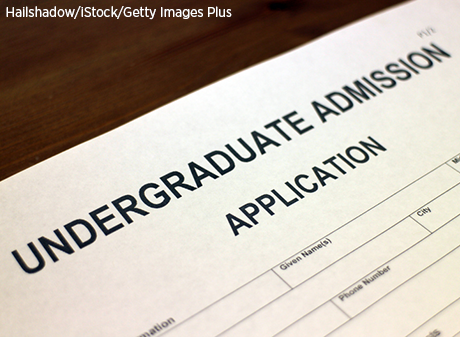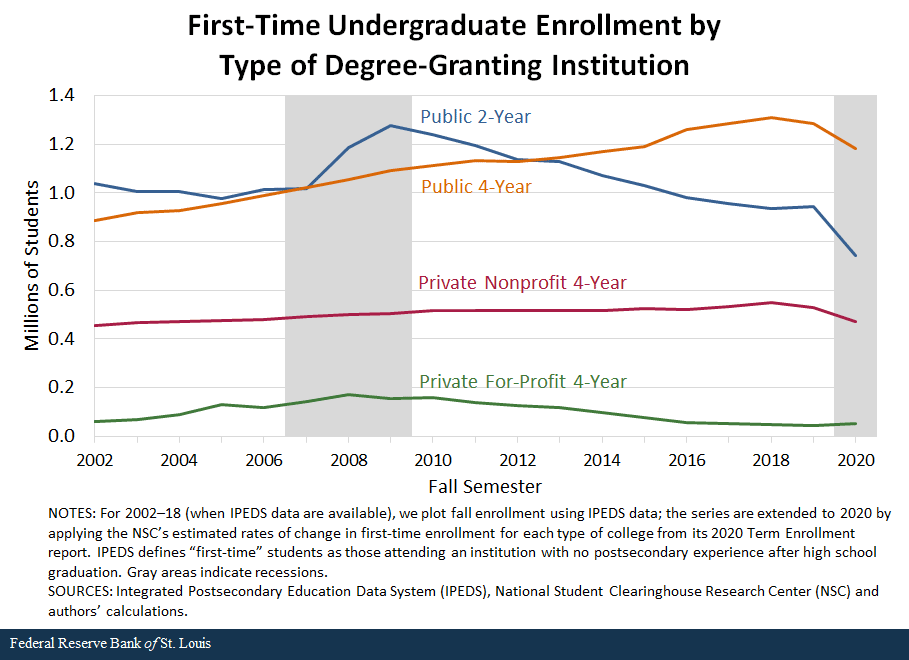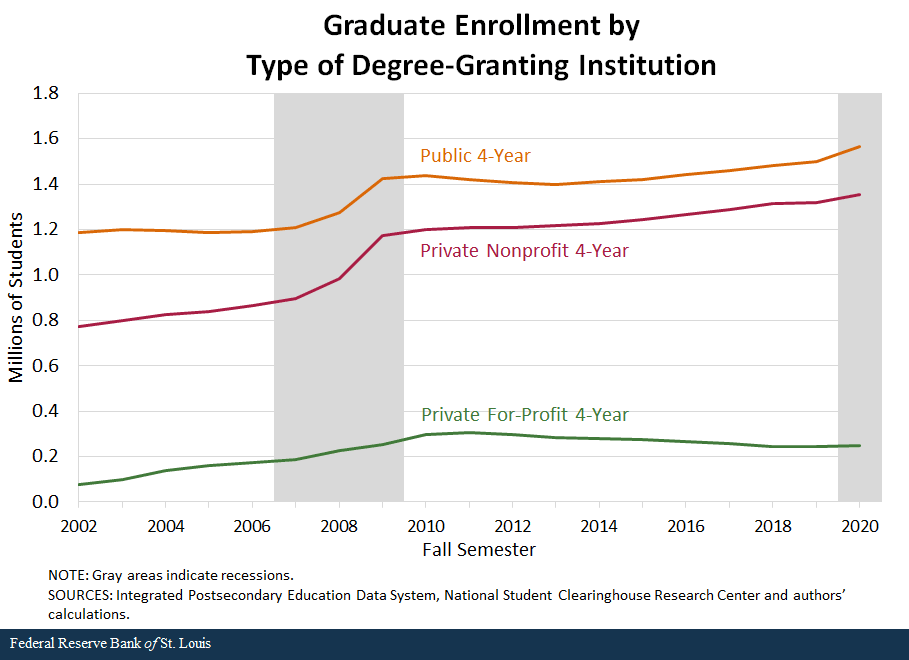The Pandemic Dents College Attendance

College enrollment dropped nearly 3% in the fall of 2020—the largest decline in decades.Estimates for last year’s enrollment come from the National Student Clearinghouse, whose figures exclude international students and so likely understate the true enrollment decline. Historical IPEDS data allow us to compare these estimates with older enrollment trends. We focus only on enrollment at degree-granting institutions. This is especially noteworthy because, in a typical recession, enrollment tends to rise as job prospects (and, consequently, the opportunity costs of college) fall.
Sharp Decline in Incoming Freshmen
This historic decline was driven almost entirely by first-time undergraduates, whose enrollment fell by 13.1%. The figure below breaks this enrollment down by type of institution.
The enrollment of first-time undergraduates declined because the perceived benefits from college—the hallowed “college experience” and the value of in-person learning—shrank as classes moved online, while relative college costs—expensive tuition at a time of widespread financial uncertainty—grew.We argue this point further (and analyze dynamics by type of college) in an upcoming article for the Regional Economist.
Slight Decline in Returning Undergrads
Returning undergraduate enrollment, by contrast, declined by 1.6%—no more than it had in recent years but still at odds with a typical recession, likely driven by the same pandemic-related concerns outlined above.
But why did this group of students respond so little compared with first-time students? First, taking a “gap year” is costlier for returning students; they have already built relationships with their college peers, and there is value in continuing college alongside one’s friends.
Returning students also likely cared less about the pandemic’s effect on college’s “in person” benefits, having already built these relationships and experienced campus life. They may have been less concerned about remote learning, having tolerated it last spring. And since returning students, on average, are more likely to come from higher-income families than incoming students,As is made clear by the fact that low-income students drop out more frequently than their better-off peers. they would be less likely to find college newly unaffordable.This is reinforced by the fact that returning enrollment declined at only two-year schools, which disproportionately enroll low-income students.
Increase in Grad Student Enrollment
The figure below shows that 2020 graduate school enrollment, by contrast, increased substantially (by 3.6%), as we would traditionally expect during recessions.
It is unsurprising that graduate students’ enrollment would be least affected by the pandemic’s unique attributes: Graduate programs focus much less on an “on-campus experience”; involve fewer, smaller classes and more independent research that potentially transitions better to remote learning; and enroll students who tend to be financially better off than the average undergraduate.See, for example, this Urban Institute report.
Less impacted by the pandemic’s idiosyncrasies, graduate enrollment shows the usual effect of a bad job market. The unemployment rate for young bachelor’s degree holders skyrocketed last summerPer Current Population Survey data and authors’ calculations.—something many in the class of 2020 no doubt saw coming, with innumerable articles last spring lamenting this dire situation.See, for example, this Wall Street Journal article from March 2020. A similar BBC article from September 2020 reported that the number of jobs on ZipRecruiter that are popular with university graduates fell 77% from February to May. Search prospects were also limited by travel-related health concerns; unable to visit locations in person, job seekers would have difficulty choosing between jobs and locations.
Many college graduates chose to forego the job market and opted for graduate school instead, building up their skills and waiting for the economy to recover. In some ways, college graduates postponing entry into the labor market were similar to high school seniors postponing college entry.
Conclusion
The ongoing pandemic and consequent recession led to large and disparate effects on college enrollment for different groups of would-be students. Analyzing these effects allows us not only to see which groups have currently been affected by the pandemic (and why) but also to question and predict what will happen going forward.
How will enrollment trends change as the pandemic itself changes and, eventually, ends? What long-term effects will we see from those classes already impacted by the pandemic—for instance, will these initial delays in college enrollment lead to better or worse educational and career outcomes for the high school class of 2020? What about the surge in graduate school enrollment? These are important questions to keep in mind as society plans for the months and years ahead.
Notes and References
- Estimates for last year’s enrollment come from the National Student Clearinghouse, whose figures exclude international students and so likely understate the true enrollment decline. Historical IPEDS data allow us to compare these estimates with older enrollment trends. We focus only on enrollment at degree-granting institutions.
- We argue this point further (and analyze dynamics by type of college) in an upcoming article for the Regional Economist.
- As is made clear by the fact that low-income students drop out more frequently than their better-off peers.
- This is reinforced by the fact that returning enrollment declined at only two-year schools, which disproportionately enroll low-income students.
- See, for example, this Urban Institute report.
- Per Current Population Survey data and authors’ calculations.
- See, for example, this Wall Street Journal article from March 2020. A similar BBC article from September 2020 reported that the number of jobs on ZipRecruiter that are popular with university graduates fell 77% from February to May.
Additional Resources
- Regional Economist: What’s behind Rising Returns to High-Quality College Education?
- Open Vault: How COVID-19 Is Affecting Students’ College Decisions
- On the Economy: Is College an Engine of Inequality?
Citation
Oksana Leukhina and Devin Werner, ldquoThe Pandemic Dents College Attendance,rdquo St. Louis Fed On the Economy, Feb. 22, 2021.
This blog offers commentary, analysis and data from our economists and experts. Views expressed are not necessarily those of the St. Louis Fed or Federal Reserve System.
Email Us
All other blog-related questions





